Manufacturing technology for building materials and products. Рубрика в журнале - Nanotechnologies in Construction: A Scientific Internet-Journal
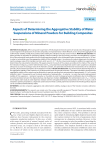
Статья научная
Introduction. When using water suspensions of finely dispersed mineral systems of natural and anthropogenic origins as active agents in the production of concrete composites, an important factor in their effective use is to ensure the aggregative and sedimentation stability of solid phase particles before adding the solid phase into the reaction mixture. Methods and materials. The paper provides an algorithm for quantifying stability criteria according to the DLVO theory provisions as exemplified by a suspension of fine polymineral sand powder from the Kholmogorskoye deposit in the Arkhangelsk region (average particle size is 195 nm). In order to successfully assess the aggregative stability of this colloidal system, it is necessary to conduct experiments for determining the analogue value of the Hamaker constant, which was 0.5 •10–20 J for the mineral sand studied, in addition to experiments for determining the zeta potential of particles. This paper presents the results of the analysis according to the criteria of the value of the interaction energy (Uint) and the sedimentation rate (Vsed) of a polymineral sand dispersed system (water suspension) calculated taking into account the analogue value of the Hamaker constant, zeta potential and dimensional characteristics of its solid phase particles, physicochemical properties of the dispersion medium. Results and discussion. It is shown that the determining factor of the aggregative stability of the suspension is the electrostatic barrier for particle interaction. Theoretical calculation showed that the aggregative stability of the system may be affected by its particles reaching their zeta potential of approximately 10–4 mV (a nearly isoelectric state). It is proposed to use the kinetic parameter of sedimentation – its velocity – to assess the kinetic (sedimentation) stability of this suspension – resistance to gravity, i.e. the ability to resist the dispersed system stratification due to the difference in particle densities between the dispersed phase and dispersion medium. Conclusion. The sedimentation rate is Vsed ≈ 4 nm/sec for the object under study in water dispersion medium with the averaged dimensional characteristics of 195 nm. At such a rate of solid phase particle precipitation, a dispersed system based on finely crushed polymineral sand from the Kholmogorskoye deposit can be considered sedimentatively stable.
Бесплатно
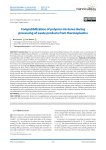
Compatibilization of polymer mixtures during processing of waste products from thermoplastics
Статья научная
Introduction. The recycling of thermoplastic waste into building materials with a long-life cycle is a promising and technologically feasible disposal direction. It is advisable to develop the processing of mixed polymer waste. Thermoplastics are thermodynamically incompatible, and technological compatibility can be controlled at the melt stage by the introduction of compatibilizers and nanofillers, the formation of free radicals in the melt, and reaction compatibilization. Materials and methods. The work aimed to study the effect of a compatibilizer – an ethylene-vinyl acetate copolymer with grafted acrylate and epoxy groups on the properties of composites obtained from mixtures of polyethylene terephthalate and polypropylene waste. The polymer mixture was melted, filled with limestone flour (50–85 wt.%), the samples were pressed, and their physical and mechanical properties were investigated. Results and discussion, conclusions. Differential thermal analysis established the melt preparation temperature of 240оC, which is below the onset of thermal oxidative destruction of the compatibilizer. It was established that the optimal ratio of polyethylene terephthalate: polypropylene: compatibilizer as 70:25:5 wt.% provided the greatest improvement in the bending strength without compromising the compressive strength of filled composites; the optimal degree of filling was found to be 60–70%. The volume fractions of polymers in the mixture are comparable. Therefore, one can expect the formation of both the matrix structure of the composite and the interpenetrating networks type structures. In both cases, the compatibilizer is distributed along the interphase boundaries. Its effect on properties can be attributed to its plastic deformation in the interfacial layer and morphological changes in the structure of the polymer mixture. There is evidence of increased structure-sensitive properties, tensile and tensile strength, of polymer mixtures containing this compatibilizer. This fact indicates an increase in adhesion between polymer phases, which is difficult to explain only for physical reasons. Possible reactions between the functional groups of the compatibilizer and polyethylene terephthalate in the melt with epoxy ring opening were analyzed. An increased effect of compatibility was revealed; however, the actual effectiveness of the compatibilizer is difficult to assess. Additional mechanical tests are required as well as optimization of the melt temperature. It is also necessary to find a balance between activating the reaction compatibilization and minimizing destructive processes in polymers.
Бесплатно
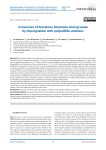
Conversion of limestone-limestone mining waste by impregnation with polysulfide solutions
Статья научная
The data of studies on the effectiveness of impregnating Aquastat waste generated as a result of the development of limestone-shell rock deposits are presented. As a result of sand impregnation, the water absorption coefficient as a result underwent a significant decrease from 7 to 17 times, while the water absorption coefficient decreases from 32.5% for the initial to 1.9% impregnated. Even treatment with low concentrated (ρ = 1.17 g / cm3) calcium polysulfide solution made the water absorption coefficient to decrease to a value of 4.5%. As a result of impregnation of crushed stone from limestone-limestone with a solution of calcium polysulfide, the water absorption coefficient decreases from 25.0% for untreated to 5.2% for treated, and the decrease in the coefficient of water absorption is greater for concentrated solutions. It was found that a solution density of 1.24 g/cm3 is sufficient to reduce the water absorption coefficient to a value of 5.2%, the same as for a density value of 1.35 g/cm3. Comparison of the results of impregnation with «Aquastat» solution and sulfur melt showed that as a result of treatment with sulfur melt, the water absorption coefficient decreases by 13.3 and strength increases by 2 times, and as a result of impregnation with «Aquastat» solution decreases by 4.62%, strength increases by 1.35 times. Despite the high efficiency of sulfur melt processing, such treatment has drawbacks associated with the use of autoclave technology and high temperatures. The results of the modification of sand and crushed stone from shell rock by impregnating it with the «Aquastat» solution, a significant decrease in the water absorption parameter, an increase in compressive strength, revealed the possibility of using impregnated crushed stone as the layer material lying at the base of the road structures of local roads in the form of crushed stone and sand instead of the more expensive imported crushed stone.
Бесплатно
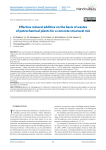
Статья научная
The use of concrete in building allows obtaining reliable and long-lasting operation of buildings, but such conditions require concrete with specified characteristics. Today hardly one can produce a concrete structural mix of high quality without any additives. To control actively the structure and properties of a concrete mix and concrete, along with chemical additives, mineral additives are used. The mineral additives are the powders of various mineral nature, obtained from natural or man-made raw materials: ground slag, rocks, etc. The article introduces the method of obtaining a mineral additive for a structural mix, in particularly for concrete. Qualitative characteristics of the additive obtained were studied as follows: the index of the degree of grinding to be equal to 1, standard consistency (normal density) – (180±5) mm with a mass ratio of «additive: water») – 100: 70, setting time – beginning 20 min, water absorption 0.27%, water content 9.65%, the proportion of insoluble residue in hydrochloric acid solution is 1.70%. Implementation of the additive in the concrete composition has shown that the quality of the product does not fall, and the actual strength is 250.7 kgf/cm2, which is slightly higher than the strength of the concrete sample without an additive. It was determined that the quality of concrete products with a mineral additive corresponds to GOST as follows: density 1775 kg/m3; mass humidity 0.3%; volume humidity 0.5%. The introduction of a structural mix will significantly improve the properties of a concrete structural mix and will also reduce the fuel resources consumption for production of the concrete structural mix, products and constructions of its basis.
Бесплатно
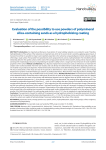
Статья научная
Introduction. An important performance characteristic of many building materials is one related to water. Therefore, hydrophobization of the surface of the material is an important task, which at the current level is solved by applying special means. It has been found that it is possible to impart water repellent properties to the surface by using polydisperse mineral materials capable of forming a rough surface. Fine powder from polymineral sand is proposed to be used as a hydrophobisate. The revealed functional relationship between the specific surface and the value of the average particle diameter of the powders, having a linear character, allows assessing their morphological structure and predicting the powder's ability to form a rough layer that enhances the water repellent properties of the surface. Methods and Materials. Four deposits of polymineral construction sands are selected as raw materials. The samples were washed and dried. Then their size modulus and true density were determined. To obtain finely dispersed powders, the raw material was ground by dry dispersion. Particle dimensional characteristics were determined by photon-correlation spectroscopy. The visual characteristic of the shape and size of the particles is determined on a laser analyzer. The specific surface area of highly dispersed rock systems was determined by gas sorption, according to BET theory. Measurement of the edge stationary wetting angle was carried out by applying a drop of distilled water to the powder surface. Results and Discussion. The dimensional characteristics of the obtained fractions showed that with a milling time (30 min) for the sands of all deposits, the average particle size (d) is 360±45 nm. At the same time, the sands of the Kenitsy and Nekhtskoye deposits have the highest values of specific surface area (Ssp). The functional relationship between the Ssp of the powders tested and 1/d was determined. The resulting linear dependencies were characterized by mathematical expressions of the form Ssp = (a/d)+b, a where reflects the rate of change in the specific surface value as the average particle diameter of the samples changes; b – is the regression line shift associated with the asymmetric shape of the particles and the non-uniformity (roughness) of the surface. It has been found that as the value of b increases, the degree of inhomogeneity of the surface formed by these particles also increases. Determination of the edge wetting angle of the surface of the powders under study showed that as the grinding time increased, the wetting angle (surface hydrophobicity) increased. So, for the surface of the fine powder of the Nekhtskoye deposit, the wetting edge angle reaches a value (114о) close in magnitude to superhydrophobicity (120о). Conclusion. The experiments showed the validity of the proposed working hypothesis related to the possible assessment of surface hydrophobicity by the experimentally determined dependence of Ssp = f (1/d). This technique can be used to select mineral powders whose fine systems are capable of hydrophobizing (if necessary hydrophilizing) the surface of the material.
Бесплатно
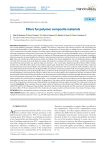
Fillers for polymer composite materials
Статья научная
Introduction. For the production of building products made of PVC, compositions are used that, along with the polymer, include additives: plasticizers, stabilizers, modifiers. This leads to a decrease in the chlorine content in the composition and increases the flammability of the productitself. Therefore, nanoparticles of various fillers are added into the compositions. Fillers inPVC compositions (more often inorganic, less often organic substances) are solid additives that differ from the polymer matrix in chemical composition and structure.In most cases, the main function of fillers is to reduce flammability and cut costs of the products obtained, in some cases they serve to impart or improve the following properties: reducing plasticizer absorption, changing in dielectric properties, increasing rigidity and hardness, reducing noise transmission, reducing toxicity of combustion products. Main part. Fillers are classified according to various criteria. According to the state of aggregation, they are divided into gaseous, liquid and solid. By their nature, they are divided into organic and inorganic; according to the source of receipt – reinforcing, strengthening, reinforcing, neutral; bythe size, particle shape and structure – into 4 main types: dispersed (powder); fibrous (fibers, threads, bundles, etc.); sheet (film) with a given structure (fabrics, paper, tapes, sheets, films, nets); volumetric (framework) with a continuous three-dimensional structure (bulk fabrics, felt, skeletal and porous frameworks). The most commonly used solid fillers, which are also called dispersed. The introduction of dispersed fillers into polymer composite materials (PCM) is more appropriate for creating mass-produced materials, more technologically advanced, with a low level of strength characteristics. Dispersed fillers are introduced into thermoplastics with high fracture energy to reduce their cost, increase stiffness and compressive strength, and improve their technological characteristics during processing. At the same time, their tensile strength and impact strength decrease due to reduction in the proportion of polymer in the filled composition. The introduction of solid and hard particles leads to an increase in the elastic modulus (E); and soft, elastic or gaseous fillers – to its decrease. According to the mechanism of action, dispersed fillers can be divided into inert ones, which do not affect the properties of the matrix and are introduced into its composition to reduce the cost of the composition, and active ones. Dispersed fillers are divided into mineral, organic and metal. The commonest of those are minerals. Conclusion. Thus, at present, there are a large number of substances and materials used as fillers and making it possible to obtain PCM with low shrinkage and shape stability of products, high mechanical properties and the necessary set of special properties. Due to fillers, PCM can compete with other materials such as glass, ceramics and even metal in most areas of human activity.
Бесплатно
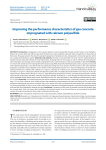
Improving the performance characteristics of gas concrete impregnated with calcium polysulfide
Статья научная
Introduction. Impregnation with a solution based on calcium polysulfide showed excellent results in the hydrophobization of concrete, brick and shell rock due to the formation of a water-repellent coating of sulfur nanoparticles on the surface of their pores. This paper presents the data of studying the properties of aerated concrete, widespread in construction practice, which has a widely developed pore system. Materials and methods. The data on the penetration of water into the studied samples of aerated concrete using the methods of visual examination, including electron microscopy, as well as methods for measuring the water absorption and strength of the samples impregnated with a solution based on calcium polysulfide are presented. Results. It is shown that aerated concrete impregnated with calcium polysulfide, despite the developed pore system, acquires pronounced water-repellent properties. It was found that the optimal processing time is 20 minutes, and the increase in the water-repellent properties of aerated concrete depends on the density of the impregnating solution. As a result of impregnation of aerated concrete by immersion in a solution with a density of 1.16 g/cm3, a decrease in 3.7 times occurs, and when treated with a solution with a density of 1.25 g/cm3, it decreases 6.8 times and becomes equal to 6%. For samples processed with the use of vacuum, in the case of processing a solution with a density of 1.16 g/cm3, water absorption decreases by 7.9 times, and when processing with a solution using vacuum, it decreases 19.8 times, while the compressive strength increases by 1.7 once. Samples of aerated concrete, treated with a polysulfide-based solution with a brush, showed that in this case, water absorption in the sprinkling mode decreases to values of 1.5–2.0%. Discussion. It is noted that during the surface treatment of aerated concrete, a chemically resistant, water-repellent layer 3–3.5 cm thick is formed, which reliably protects the material from the penetration of water and chemicals. The results of the performed experiments give reason to believe that on the surface of the pores of aerated concrete treated with a solution based on calcium polysulfide, as well as on the surface of the pores of previously investigated materials, a nanosized coating is formed of sulfur particles that hydrophobic aerated concrete. Conclusions. Comparison of the results for aerated concrete with excellent data for concrete, brick, shell rock shows that the efficiency for aerated concrete is no less and allows us to recommend the specified solution for long-term protection of the surface of aerated concrete walls
Бесплатно
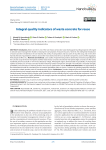
Integral quality indicators of waste concrete for reuse
Статья научная
Introduction. Waste concrete is one of the main heavy construction waste having good recycling prospects with regard to rational nature management related to reducing the consumption of natural resources. However, the widespread introduction of waste concrete is hindered on the one hand by the variety of compositions and structures of recycled scrap, and on the other hand by the lack of quantitative criteria to choose the most rational area of its use (a binder component, coarse and fine aggregate, finely dispersed filler, etc.). Materials and methods. Case studies of experimental powders obtained by mechanical grinding from the concrete scrap of internal wall panels and floor slabs (heavy concrete) and external wall panels (light concrete) of a five-storey residential panel house built in 1979 in the Obozersky village, Arkhangelsk region, demonstrated the possibility of choosing the optimal secondary use of waste concrete fractions featuring residual compressive strength. The indicators of residual strength, grindability and contraction of mineral powders were used as optimization criteria. Results and discussions. The applicability of the mathematical model for calculating the raw material grindability index is shown. A criterion for grinding equipment selection is proposed to obtain powders with an extended active surface. Conclusions. Powders obtained from the fraction of waste light concrete featuring low strength properties and grindability by mechanical grinding to a specific surface area comparable to that of Portland cement used and having a higher value of contraction can be rationally used as a composite binder component. Concrete scrap fractions featuring by higher grindability and strength properties are optimally suited for crushed aggregate preparation in the concrete composite production process.
Бесплатно
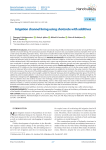
Irrigation channel lining using shotcrete with additives
Статья научная
Introduction. Shotcrete lining is the most economical and quite fully mechanized in production among all the known varieties of concrete linings. The construction practice of hydraulic structures has accumulated numerous examples of the use of a wide variety of building materials in lining – from stone to modern films made of synthetic resins. Despite the very active efforts to find more suitable materials, concrete lining will remain the main one for a long time. Accordingly, concrete lining requires further improvements, increasing durability and reducing cost. Methods and materials. The studies were carried out by the comparison method of laboratory tests of shotcrete with nanostructured surfactants additives. In the form of nanostructured additives, SCL (sulfite-cellulose liquor), NAR (neutralized air-retaining resin), cotton soap and bitumen were used in various consistency. The tests were conducted on strength properties, shrinkage, tension deformation, adhesion strength and water permeability. Structural changes in the properties were studied by electron-microscopic analysis. Results and discussion. It is established that the optimal proportion of SCL additive to the shotcrete gauged water, under the spraying condition, is 0.5% by the cement weight. NAR additive is not observed. When cotton soap additive with gauged water are added into the shotcrete, the water content in the placed shotcrete increases as the amount of the additive added increases, the optimal cement content in the shotcrete is observed when 0.3% cotton soap additive by the cement weight is added. The “rebound” decreases when the additive proportion grows. The 0.3% SCL additive by cement weight added in 1:4 dry mixture shotcrete increases its compression strength by 16%, bending strength by 1% and tension strength by 20%. Conclusion. All nanostructured surfactant additives increase the shotcrete shrinkage. The shotcrete with SCL additive shows the smallest increase in the shrinkage, and the largest – with bitumen emulsion. The additives used in shotcrete significantly increase its tension deformability, and in a wide range reduce the values of the shotcrete instantaneous elasticity modulus, i.e. enhance its plastic properties. The surfactants and bitumen emulsion reduce the adhesion strength between shotcrete and reinforcement, however, it remains at a higher level than that of conventional concretes.
Бесплатно
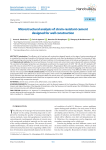
Microstructural analysis of strain-resistant cement designed for well construction
Статья научная
Introduction. The efficiency of oil and gas well construction depends largely on the stage of casing cementing and is completed by checking the quality of its fixing by various methods, most often by geophysical methods. The necessity of highquality cementing and ensuring the quality of technical conditions in the subsequent years of oil and gas well operation is the main task. Materials and methods. Microstructural features of cement slurries and cement stone were analyzed with advance methods. The essential technological properties were developed according to the requirements of GOST 1581-96 and API standards (API spec.10B). Class G cement (PCT-I-G) was used for all formulations. Polypropylene fiber and expanding additive СMA were used to increase impact resistance and to ensure tight contact with the confining surfaces of the obtained plugging stone. Microstructural analysis of the obtained cement stones and developed plugging mortars was carried out by X-ray diffraction (XRD) and scanning electron microscope (SEM). Results and discussion. The results of the study showed that the expanding additive in tandem with polypropylene fiber works effectively to ensure the integrity of the cement ring. Conclusion. Microstructural analysis of plugging stones showed a tight bond between polypropylene fiber and cement stone at a concentration of – 0.25%. The expanding additive is fully hydrated and the obtained cement stone has no expansion cracks at 7 days. The developed grouts with a water-cement ratio of 0.44 showed high compressive strength.
Бесплатно
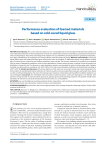
Performance evaluation of foamed materials based on cold-cured liquid glass
Статья научная
Introduction. The current trend of transition to non-combustible and environmentally friendly thermal insulation and sound-absorbing materials involves development of research to obtain foamed silicate compositions, particularly those based on cold-cured liquid glass. The primary advantage of this material is its eco-friendliness throughout both its operational and production stages, facilitated by the employment of energy-efficient manufacturing technology. Materials and methods. Cold-cured liquid sodium glass and cullet-based foam glass were used as main raw materials. To determine optimal curing additive of liquid glass, Portland cement, slaked lime and sodium ethylsilicate were selected. The thermal conductivity of materials was evaluated with by means of appropriate coefficient, value of which depended on volume content of pores in material, nature of porosity and distribution of pores by size. The decrease in water absorption capacity was estimated by value of wetting edge angle. Sorption humidity was determined in accordance with GOST 24816-2014, and sound absorption coefficient was determined according to GOST 16297-80. Results and discussion. The prime objective of this study was to examine trends and provide explanations for the formation of specified performance indicators of thermal insulation and sound-absorbing materials, particularly those based on cold-cured foamed liquid glass. The issue of increasing water resistance of material by selecting effective additive-hardener was also investigated. Conclusion. The developed thermal insulation material based on cold-cured liquid glass is eco-friendly, with presence of large number of small and mainly open pores, giving it good sound-absorbing properties. The problem of high-water absorption of material was solved by introducing Portland cement as a curing additive.
Бесплатно
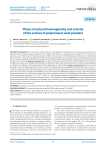
Phase-structural heterogeneity and activity of the surface of polymineral sand powders
Статья научная
Introduction. The value of the specific surface (Ssp), the degree of crystallinity (С, %) and surface activity (ks) plays an important role in creating various compositions. The increase in the size of Ssp is associated with a change in the “С” of rock powders, the value of which characterizes the properties of fillers. The reactivity of the finely dispersed material can be determined by the value of ks, which allows quantifying transition of the potential energy into free surface energy by activating the surface of the raw material. Therefore, determining the functional relationship between the parameters characterizing the reactivity of rock powders is an urgent task. Methods and Materials. Four deposits of polymineral construction sands are selected as raw materials. To obtain fine powders, the samples were ground by dry dispersion. The specific surface area of rock systems was determined by gas sorption. Crystallinity was calculated from the X-ray diffractogram of the samples. Results and Discussion. The certain sizes of specific surfaces for highly dispersed rocks have shown, that deposits “Kenica” and “Nekhtskoye” possess the greatest values Ssp. The study of the phase-structural heterogeneity of the samples, showed a significant increase of the content of the amorphous phase. At the same time, the degree of crystallinity for the sands “Kenica” and “Nekhtskoye” deposits decreases 25%. The functional relationship between the surface activity and the shares of the amorphous component (c) for highly dispersed sands was characterized by mathematical expression ks = 21•10–6•c+0,58•10–6. The identified dependence demonstrates the relationship between the parameters of the phase-structural heterogeneity and ks of fine-dispersed samples. Conclusion. The results obtained showed that mechanical dispersion contributes to the activation of raw materials. This is due to the breakability of the crystal structure of minerals and the texture of the raw materials. These characteristics are reflected in the value of the activity of the surface of finedispersed systems of the rocky rocks.
Бесплатно
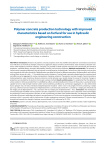
Статья научная
Introduction. Research of polymer concrete properties show that it differs favorably from conventional concrete by such indicators as mechanical strength, resistance to aggressive impact of various environments, water resistance, abrasion resistance, water-repellency and frost resistance. Currently, it is possible to obtain polymer concrete with characteristic and chemical properties –specified density, strength, deformability, ductility, and corrosion resistance. Methods and materials. The research is carried out by comparing laboratory tests of polymer concrete based on furfural binder. Furfural has a high reactivity and can form resin compounds with many chemicals. Diphenylamine was added to furfural in different proportions. Benzenesulfonic acid, sulfuric acid and their mixture at a ratio – 1:1 by weight were used as hardeners. Crushed sand or ground andesite based on nanostructured microfiller served as aggregate for various compositions of polymer solutions. The polymer concrete strength, chemical resistance, lasting properties, water resistance, abrasion resistance, metal adhesion were tested during the research. Structural changes in properties were studied by the electron microscopic analysis method. Results and discussion. It is established that the diphenylamine solution in furfural, provided that it is solidified by sulfuric acid, benzolsulfoacid or mixture of these acids, is a polymer binder capable to form a high-strength material under normal hardening conditions by acid-resistant aggregates. It is also determined that to prepare resin, the ratio of furfural and diphenylamine should be within 1:0.5–0.3 by weight. The resin containing 1 weight part (w.p.) of furfural and 0.5 weight part of diphenylamine is conventionally named FD-1; containing 1 weight part of furfural and 0.4 weight part of diphenylamine – FD-2 and resin with 0.3 weight part of diphenylamine – FD-3. Conclusion. The introduction of nanostructured microfiller into the polymer concrete composition could save expensive resin. Comparison of the technologies for producing FD resin and polymer concrete, as well as preliminary test data of the studied materials, can determine the possible technical and economic advantages of polymer concrete based on FD resin over the polymer concrete based on FA (furfurolacetone) monomer which is currently used in construction of hydro-engineering structures. Polymer concrete based on FD resin has high strength and exceeds the strength of polymer concrete based on FA monomer by 20–25%.
Бесплатно
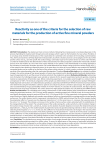
Статья научная
Introduction. The simplest and most common method of obtaining fine mineral powder is mechanical dispersion. In the process of grinding the material went through some work (energy), which is spent on the formation of a new surface. Therefore, it is not always clear whether the destruction of the crystal lattice of a solid lead to the activation of the resulting crushed material. Thus, the key characteristics of finely dispersed mineral powders, by which activation processes can be judged, are the value of the specific surface area (Ssp) and the specific free surface energy, numerically equal to the surface tension (σ) of the solid. Therefore, a number of models based on the determination of these characteristics have been proposed to estimate the mechanical activation process of the raw material. So, one of the most correct methods, in our opinion, is the method based on an energy approach to the evaluation of mechanical activation processes. This model determines the relative change in the free surface energy (ΔES/ES0) of the material when obtaining a dispersed system. At the same time, the choice of the most effective raw materials for obtaining composite binders can be carried out on the basis of the surface activity criterion (ks), which is used as a criterion characterizing the reactivity of fine mineral powders after their mechanical disintegration. Therefore, the aim of this study was to calculate the relative change in the surface energy of fine mineral powders of various raw materials and to identify possible functional relationship between the parameter ΔES/ES0 and the amount of surface activity for the studied rock systems. Methods and Materials. Sedimentary rocks formations the Arkhangelsk region were selected as materials for the research: polymineral sand and saponite-containing material (a representative of bentonite clays). Before conducting experiments, rock samples were brought to a constant mass at a temperature of 105оС. The chemical composition of the samples was determined on an X-ray fluorescence analyzer “Metexpert”. Highly dispersed rock fractions were obtained by dry grinding on a planetary ball mill Retsch PM100. The dimensional characteristics were determined using the DelsaNano submicron particle size analyzer by photon correlation spectroscopy. The specific surface area was determined by the gas permeability method on the PSX-10 device. To calculate the surface tension, the edge angle was measured on the “Easy Drop” installation. The surface tension for highly dispersed samples was calculated by the OWRK method. Results and Discussion. The calculated macro-energy characteristics of the studied samples have showed that the atomization energy for polymineral sand was 1910.72 kJ/mol, and for saponite–containing material was 1826.94 kJ/mol. At the same time, the mass specific atomization energy for sand and SCM are 30.41●103 kJ/kg and 26.94●103 kJ/kg, respectively. In the process of dispersion, several fractions of highly dispersed rock powders were obtained, which are characterized by an average particle size and specific surface area. The surface tension (and its components) calculated by the OWRK method showed that for all the samples studied, the polarization effect (σS P) prevails over the dispersion interaction (σS D). At the same time, as Ssp increases, the numerical value of the ratio σS P/σS D increases. This indicates an increase in the number of active surface centers associated with the redistribution of the energy potential of the system. The calculated values of free surface energy (ЕS), surface activity (ks) and the relative change in free surface energy showed, that ks and ΔES/ES0 increase as the duration of powder dispersion increases.The obtained functional dependences ks = f(ΔES/ES0) for the studied samples of polymineral sand and saponitecontaining material are linear in nature and obey the general equation у = a●x + b. In this case, the coefficient “a” characterizes the dynamics of changes in the reactivity of the material with an increase in the duration of mechanical grinding, and the parameter “b” – reactivity in the microstate. Comparison of the coefficients “a” of the studied dispersed systems showed that, unlike polymineral sand, the reactivity of saponitecontaining material increases 1.5 times faster as the grinding duration increases. The obtained functional relationship between the criteria used for evaluating the process of mechanical activation of mineral raw materials of various natures shows the correctness of the models used. Conclusion. The calculated macro-energy characteristics of rock samples showed that the atomization energy for polymineral sand and saponitecontaining material has similar values. To assess the effectiveness of the process of mechanical activation for mineral raw materials, it is proposed to use the relative change in free surface energy or surface activity.
Бесплатно
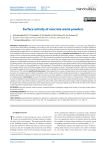
Surface activity of concrete waste powders
Статья научная
Introduction. One of the most large-tonnage wastes of the construction industry is a concrete scrap, obtained as a result of the dismantling of buildings and structures, the service life of which has reached its maximum or requires significant capital changes. In our opinion, works on the use of the resulting dust-like fraction are of particular interest. One of the promising methodological approaches in this direction is the observance of the principles of nanotechnology, which consists of obtaining finely dispersed components as active components of the created compositions. Materials and methods. Therefore, the objects of research in this work were fine powders obtained by mechanical grinding of lightweight (sample 1) and heavy (sample 2) concrete of a five-story residential panel house built in 1979. The elemental composition and specific surface area of the samples were determined, thermogravimetry of the studied powder systems was carried out, the surface tension of the experimental samples and the dispersion and polarization components of this indicator were determined by the OVRK method. A new methodological approach to the determination of the surface tension of powder systems is proposed, based on the determination of the functional dependence of the surface tension on the pressing force of the prototypes. The possibility of calculating macroenergy characteristics (atomization energy, specific mass atomization energy) of waste concrete samples is shown. These physicochemical indicators characterize the potential supply of internal energy of the system, which is capable of transforming into free surface energy during mechanical destruction of the material. Results and discussions. Thermogravimetric analysis of experimental concrete samples showed the presence of a residual amount of belite. Calculations of the surface activity of the samples showed that it is more preferable to use a powder obtained by crushing a sample of heavy concrete as an active additive in compositions capable of exhibiting the properties of a binding agent. Conclusions. To assess the activity of dusty fractions of concrete scrap as a component in binding compositions of the hydration type of hardening, it is proposed to use the value of the surface activity of powder systems as a criterion. The absolute numeric value of this criterion is equal to the ratio of the values of the free surface energy of the investigated powder and the specific mass energy of atomization of the initial waste concrete. It was found that for concrete waste the value of this criterion is determined by the polarization component of surface tension.
Бесплатно
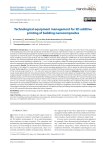
Technological equipment management for 3D additive printing of building nanocomposites
Статья научная
Introduction. The development of innovative approaches to digital equipment control that ensure the production of 3D building structures with high operational and technical-economic characteristics remains an urgent task. The handling and maintenance of technological equipment during the process of 3D-printing of construction objects do not always meet the modern requirements of technical systems management. Methods and materials. 3D-printing is based on the method of extrusion: molding of a building structure layer-by-layer with the addition and fairly rapid subsequent solidification of nanocomposite building materials. The resulting optimized nanocomposition must have the required rheology, which set the comb-like polycarboxylate esters with nanosteric repulsion at a distance of ≈ 11 nm. In order to organize a stable 3D-printing technology, it is also necessary to select the appropriate optimal fillers that provide the necessary physical, mechanical and operational characteristics to the hardened nanocomposite. Results. The effectiveness of three-dimensional printing calls for the coordinated operation of a construction-grade 3D-printer. In this regard, it is necessary to have concrete pumping equipment that is able to pump the initial nanocomposition through flexible pipelines at a certain speed. It is necessary to consider the influence of pressure and volume to increase the power of the concrete pump motor by 14–17%, and at the same tine reduce the level of vibrations. Discussion. Digital 3D-technologies reveal unique opportunities for innovative production of three-dimensional construction objects and engineering structures. Technological quality management of 3D-printing depends on the correct alignment of the printer mechanisms, and the reduction of defective products can be achieved by adjusting the molding parameters of building nanocomposites. The structure-forming curing of Portland cement nanocomposites is based on the formation of fractal structures of calcium hydrosilicate clusters with dimensions of 47–51 nm, that form nanoaggregates (125–132 nm), which gradually cement the fillers due to adhesive interactions. The high demand for the corresponding equipment only strengthens the advantages of 3D-additive technologies: its practical waste-free operation, low power consumption of 3D-printers, time reduction of design-to-completion process by 8–11 times. Conclusions. Technological managing of concrete pump equipment for 3D-additive printing of building nanocomposites reduces energy costs by 26–29%, and at the same time reduces the level of vibration.
Бесплатно

